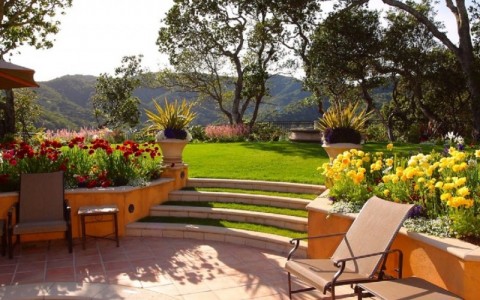
Defensible space is the area immediately surrounding your home that is designed to reduce fire hazard, otherwise known as “firescaping.” For states that annually combat regional wildfires like California, Washington, Idaho and Colorado, the idea of creating a natural fire boundary, or defensible space, is not only appealing, it may actually be a law. In California, the 100-foot defensible space rule was made law in 2005. Limiting the amount of flammable vegetation situated near your home will help decrease your chances of catching fire in the home ignition zone, which is the zone between your home and up to 100-200 feet around the home. Although the concept of firescaping doesn’t prevent floating embers from landing on the roof, establishing a defensible space can be one way to create a layer of fire prevention.
The 3 defensible zones
When designing the landscape and floor plan of your home, consider defensible space for your property to provide a buffer between your home, landscape, and neighbors. While the space between you and your neighbors adds a natural separation, there are 3 zones that have distinct significance when it comes to defensible space. The Ready for Wildfire website has some great information regarding designing your property for wildfire spread prevention. Check out their handy guide for further illustrations.
Zone 1: 0-30 feet from your home
Make this zone wet, green and non-flammable. The space directly bordering your home should be clear of flammable materials and should be designed to not transfer fire. For most homes, this zone houses exterior structures such as decks and fences, as well as flammable objects like gas grills, heated oil tanks, vehicles or stacked firewood. You should also take precautions with your home itself for example, consider a metal or slate roof if you live in a hazardous zone. The following are some tips to reducing your risk of close structures lighting fire by windblown embers or other igniting materials that may expose your home to fire:
- Prune trees and shrubs off of the ground
- Remove brush, branches, leaves, and pine needles
- Mow the lawn regularly
- Keep your lawn and plants well-watered
- Clean out under-deck debris
- Remove large piles of firewood or other flammable materials
- Trim back branches and limbs 10 feet or more from your home and from other trees
- Refrain from having flammable plants like juniper and sagebrush
- Utilize stone, rocks or other non-flammable materials in your landscape design
- Keep garden hoses connected
- Move boats or other gas-fueled vehicles to the edge of your property
- Install a fire-resistant roof system and keep gutters empty of debris
- Consider installing a roof sprinkler system if wildfires are a regular occurrence
- Install an independent water reservoir when main water supply is low
Zone 2: 30-100 feet from your home
This second reduced fuel zone is the space out to 100 feet away from your home. This area most likely contains larger trees and shrubbery that is well-irrigated but may still be tightly packed together. The objective of this space is to thin the area and separate vegetation to reduce the chance of flammability. While some of this vegetation is natural and not planted by you as the homeowner, be aware of the following ways to lower your chances of a wildfire catching your property’s vegetation:
- Remove all dead trees, shrubs, and plants
- Thin your trees by creating horizontal spaces
- Trim lower branches so that a 6-foot clearance is created from ground to first branch
- Remove piles larger than 3 inches of brush, branches, leaves, and pine needles
- Create vertical spacing between trees and shrubs (vary the heights)
- Add “fuel breaks” such as pathways or lawn between clusters of vegetation
Zone 3: 100 feet or more from your home
The last zone signifies the area past Zone 2, out to your property line and beyond. If you have a larger property that goes past 100 feet, this is a space of vegetation that must be thinned to reduce the speed of a potential wildfire. If you store machinery, trailers, or other wood structures within this area, separate them from nearby vegetation to lower the risk of catching heat in the case of a wildfire. You can also decrease flammable vegetation by cutting down the thickness of your trees so that the dense canopies that usually provide shade are trimmed and less likely to spread a flame to one another.
There are many ways to decrease the chances of a wildfire spreading onto your property, or even worse to your home, but there are also indoor hazards when it comes to your fireplace. Read our fireplace safety tips to learn how to safely use your fireplace and avoid costly mistakes. If you are unsure how to properly design your landscape to minimize flammable vegetation and materials, hire a professional landscaper to help you construct a safe outdoor environment.
Top Image Credit: Pedersen Associates